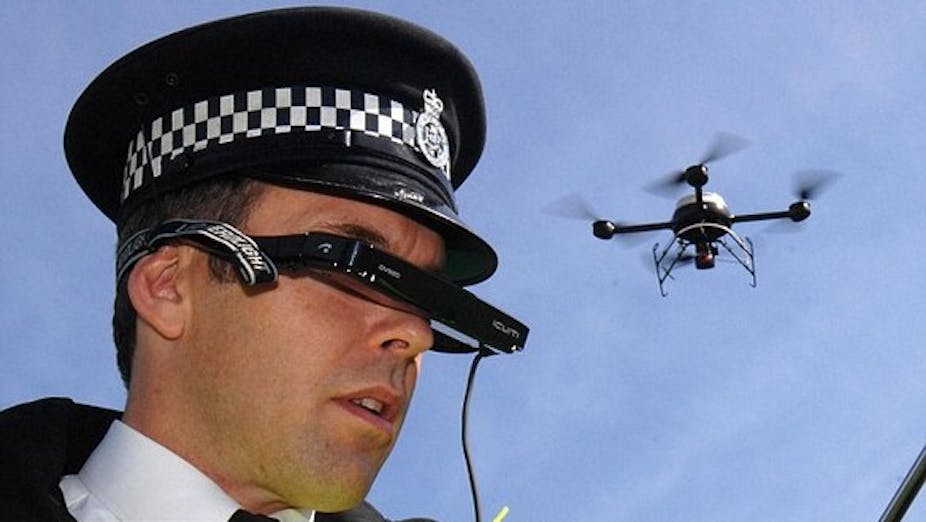Before the election, Tony Abbott reaffirmed the Coalition’s commitment to purchasing unmanned “drone” aircraft for military use, but he emphasised the need to review their efficacy and cost effectiveness.
While the Australian military contemplates entering the drone age, Australian police forces are already committed to taking that step.
The South Australian police have announced plans to purchase four “quadcopters” - miniature aircraft lifted and propelled by four rotors.
Police in other states are seeking public funds to buy their own drones. The Queensland Police Minister Jack Dempsey says drones are “invaluable” tools for policing.
The use of drones overseas, in the military or for border patrol, has been the subject of international controversy. But police use of drones has gone largely unremarked in Australia despite their implications for privacy and civil liberties. Meanwhile it is still unclear exactly how drones will improve law enforcement efforts.
Australian police say drones will help foil terrorist plots, infiltrate bikie fortresses, and find survivors in flaming towers.
The international experience suggests otherwise.
The view overseas
In the United States, where around 20 police forces have approval to use drones, the majority have never deployed them in the field. They cite legal uncertainties, the high ongoing costs of drones and their apparently limited usefulness for day-to-day policing.
Drones were used in Britain for more than two years before resulting in a single arrest.
In 2010, UK police used a drone mounted with thermal-imaging technology to find a teenage car thief hiding behind bushes in thick fog. The drone was almost immediately grounded for breaching legislation regarding unmanned aircraft in inhabited areas.

After police obtained the necessary license, officers took the £13,000 drone to the local police social club where it was launched only to crash and sink into a river.
Drones are notoriously difficult to pilot. In 2009, the American Air Force reported that one third of their Predator drones deployed in Iraq and Afghanistan had crashed. The high rate of drone accidents raises obvious questions about the potential risks associated with police use.
In 2012, a Texas paramilitary police unit staged a photo opportunity for the local media to photograph a drone in action. Minutes after launching the US$300,000 Shadowhawk helicopter there was a communication failure and the drone crashed into a police vehicle.
Separating fact from the hard sell
Rather than being based on fact, the dramatic claims of Australian police about the crime-fighting powers of drones appear to parrot the marketing material of weapons manufacturers and military industry groups. As Western countries withdraw forces from the Middle East, the weapons industry is directly advertising drones to police agencies to find new revenue streams.
They have employed lobbyists who make wild claims about the inexpensiveness, safety and usefulness of drones for law enforcement.
But independent cost benefit analyses find that manned aircraft are more effective than drones for policing. The unimpressive results of police drones come at a high financial cost.
Drones are cheaper per unit than piloted aircraft but their operational costs are substantially higher, due to the ongoing expenses of pilot training, licensing and operation. Operating a drone may cost as much or more than a manned aircraft.
Militarising boys in blue
Police fascination with drones, despite their limitations, is part of a longstanding trend towards the militarisation of policing in Australia and overseas.
Since the mass media became saturated with heroic images of the warrior cop in the 1980s, police have exhibited a strong attraction to military fashion, tactics and hardware.
They describe military training and weaponry as thrilling and exciting, in contrast to the more mundane realities of police life.

This excitement comes at a high cost. Military trained police and units have shown a preference for force that erodes community trust and has resulted in unnecessary injury and even death to officers, suspects and bystanders.
The potential harms of military ordinance in the hands of police officers are well known.
Police have sought to distance drones from their origins in the military-industrial complex, likening them to existing police aerial resources such as helicopters. After all, drones have proven very useful in disaster responses, such as in the aftermath of the Fukishima nuclear plant disaster, or in monitoring fires or floods.
But it is becoming clear that police interest in drones is due, at least in part, to their weaponised potential. American police agencies are openly speculating that they may equip drones with “bean bag” guns, tear gas canisters and rubber bullets.
Military manufacturers have developed weaponised drones for domestic application and are marketing these “assassin bugs” to police agencies and governments.
The use of drones in military action overseas has sparked concern that drones undermine democracy because they make going to war too easy. But we are so used to the “war on crime” and the “war on terror” at home that the political and ethical implications of policing drones are passing us by.
Military tactics and hardware can make policing more appealing to recruits and generate impressive media spectacles, but they do not prevent or solve crime.
The underlying causes of social disorder go unaddressed while public funds are spent instead on expensive but ineffective and potentially dangerous toys.

